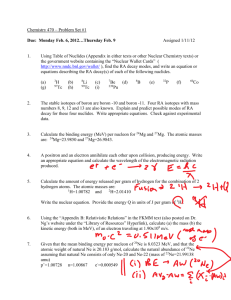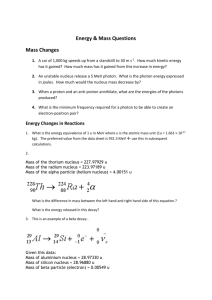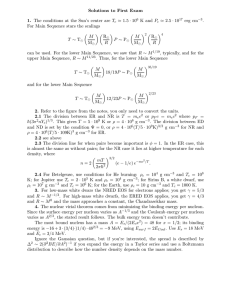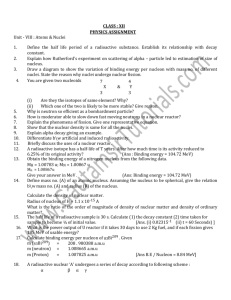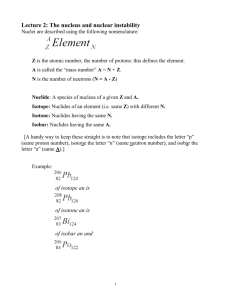Selected Topics in Physics Lecture 11
advertisement
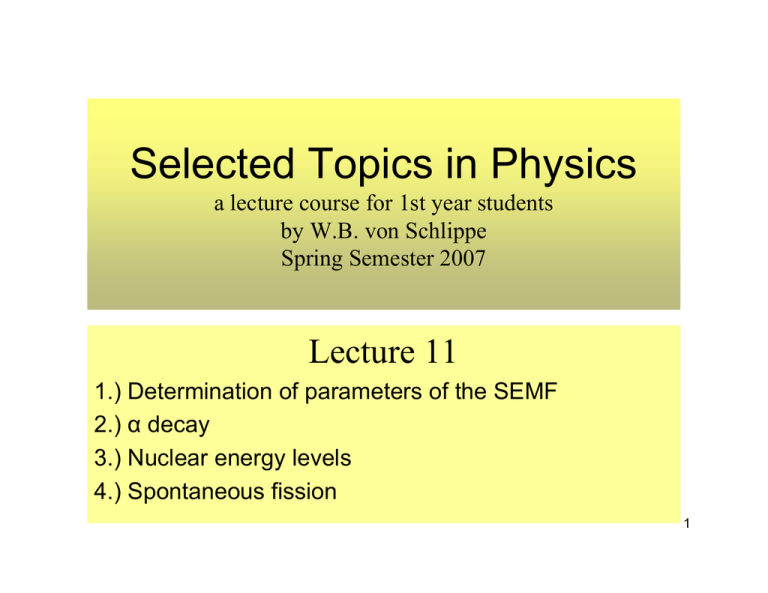
Selected Topics in Physics
a lecture course for 1st year students
by W.B. von Schlippe
Spring Semester 2007
Lecture 11
1.) Determination of parameters of the SEMF
2.) α decay
3.) Nuclear energy levels
4.) Spontaneous fission
1
1.) Determination of parameters of the SEMF
1.1) Determination of the Coulomb term from mirror nuclei
1.2) Determination of the asymmetry term from line of maximum β stability
1.3) Estimate of the pairing term
1.1) Determination of the Coulomb term from mirror nuclei
In Lecture 9 we have derived a formula for the binding energy, based on the
liquid drop model:
2
B( A, Z ) = a1 A − a2 A 3 − a3
Z ( Z − 1)
A
1
3
− a4
(N − Z)
A
2
+δ
where the terms are, in that order: volume term, surface term, Coulomb term,
asymmetry term and pairing term.
We can see that the volume and surface terms are identical for isobars.
Therefore, if we compare the binding energies of two isobars, then these
terms cancel.
2
If we choose these isobars to be odd-A mirror nuclides, then the asymmetry
term also cancels.
Mirror nuclei:
Two nuclides are called mirror nuclei if they have equal mass
numbers A, and if the number of protons Z in one of them is
equal to the number of neutrons N in the other.
Examples of mirror nuclei:
:
11
5
carbon-13 and nitrogen-13 :
13
6
boron-11 and carbon-11
B − 116 C
C − 137 N
If we define the neutron excess of a nucleus by
T = N −Z
(also called isotopic number), then we have for odd-A mirror nuclei
T = ±1, and hence Z = N ± 1
3
Thus these mirror nuclides lie next to the line
N = Z in the Segre chart.
Now we know from the Segre chart that the band of stability moves
with increasing A away from the line N = Z towards neutron-rich nuclides,
and unstable nuclides are never very far away from the band of stability.
Therefore we must expect
that mirror nuclides are
found only up to mass
numbers
A
around 60.
All mirror nuclides with
A >10 are shown in the
following table
4
Mirror nuclides from
A = 11 to A = 63: there are no mirror nuclides with A > 63
N - Z = +1
N - Z = -1
N - Z = +1
N - Z = -1
A
Nuclide
Z
Delta
Nuclide
Z
Delta
A
Nuclide
Z
Delta
Nuclide
Z
Delta
11
B
5
8.668
C
6
10.650
39
K
19
-33.807
Ca
20
-27.274
13
C
6
3.125
N
7
5.345
41
Ca
20
-35.135
Sc
21
-28.642
15
N
7
0.101
O
8
2.856
43
Sc
21
-36.188
Ti
22
-29.321
17
O
8
-0.809
F
9
1.952
45
Ti
22
-39.006
V
23
-31.880
19
F
9
-1.487
Ne
10
1.751
47
V
23
-42.002
Cr
24
-34.560
21
Ne
10
-5.732
Na
11
-2.184
49
Cr
24
-45.331
Mn
25
-37.620
23
Na
11
-9.530
Mg
12
-5.474
51
Mn
25
-48.241
Fe
26
-40.220
25
Mg
12
-13.193
Al
13
-8.916
53
Fe
26
-50.945
Co
27
-42.640
27
Al
13
-17.197
Si
14
-12.384
55
Co
27
-54.028
Ni
28
-45.340
29
Si
14
-21.895
P
15
-16.953
57
Ni
28
-56.082
Cu
29
-47.310
31
P
15
-24.441
S
16
-19.045
59
Cu
29
-56.357
Zn
30
-47.260
33
S
16
-26.586
Cl
17
-21.003
61
Zn
30
-56.350
Ga
31
-47.090
35
Cl
17
-29.014
Ar
18
-23.047
63
Ga
31
-56.547
Ge
32
-46.900
37
Ar
18
-30.948
K
19
-24.800
Delta is the mass excess in MeV;
the values are from the BNL Wallet Cards 2005, http://www.nndc.bnl.gov/wallet/
5
Let us now compare the binding energies of mirror nuclides using the SEMF:
we have
2
B( A, Z ) = a1 A − a2 A 3 − a3
or in terms of
A
and
Z ( Z − 1)
A
1
3
− a4
(N − Z)
2
A
+δ
T = N – Z:
2
A
−
T
A
−
T
−
2
(
)(
)
1
T
− a4
+δ
B( A, T ) = a1 A − a2 A 3 − a3
1
4
A
A3
2
hence
ΔB ≡ B( A, T = +1) − B( A, T = −1)
1 ( A − 1)( A − 3) − ( A + 1)( A − 1)
= − a3
1
4
A3
= a3 ( A − 1) A
−1
3
6
Thus, if we plot the measured differences of the binding energies as
a function of (A-1)/A1/3, then we expect a straight line through the origin.
This is shown in the next figure.
Determination of the Coulomb coefficient from mirror nuclei
12
Delta E_Coulomb (MeV)
y = 0.6448x
10
8
6
4
2
0
0
5
10
(A-1)/A^(1/3)
15
20
7
The slope of the line, which is constrained to pass through the origin,
is the empirical coefficient a3 of the Coulomb term. The least squares
fit gives
a3 = 0.645 MeV
1.2) Determination of the asymmetry term from line of maximum β stability
In the previous lecture we have defined the position of maximum β stability:
∂M ( A, Z )
=0
∂Z
A= const
Now, the mass
M(A,Z) is given by
M ( A, Z ) = ZmH + ( A − Z ) mn − B ( A, Z ) c 2
hence
8
Z min
mn c 2 − mH c 2 + a3 A−1 3 + 4a4
=
2a3 A−1 3 + 8a4 A−1
thus the position of the minimum of the mass parabola is determined
by the coefficients
Solving for
a3 (Coulomb term) and a4 (asymmetry term).
a4 we get
mn c 2 − mH c 2 + a3 (1 − 2Z min ) A−1 3
a4 =
8Z min A−1 − 4
Empirically, fitting the masses of isobars with parabolas, we will get
somewhat different values of
a4. Then these values are averaged.
From fits to only a few mass parabolas of mass numbers A = 15, 63,
65, 97, 101, 107 and 135 I have got the following result:
a4 = 21.8 ± 1.3 MeV
9
1.3) Estimate of the pairing term
The pairing term δ is nonzero only for even-A nuclides.
In lecture 9 we have seen in the discussion of stability rules that of the 174
stable even-A nuclides, 166 are even-even and only 8 are odd-odd nuclides.
Four of the odd-odd stable nuclides are light nuclides:
deuterium, lithium, boron and nitrogen;
they are absolutely stable and symmetric, i.e.
N = Z.
The remaining four odd-odd nuclides are unstable but have lifetimes
greater then 109 years, i.e. greater than the age of the earth:
K
1.3 ×109 years
V
1.4 ×1017 years
40
19
50
23
138
57
La
1.1×1011 years
Ta > 1.2 ×1015 years
180 m
73
10
We will be guided by these stability rules to estimate the pairing term δ
To do this we rewrite the expression for the minimum of the mass parabola
in terms of the neutron excess T:
Tmin = A − 2Z min
a3 ( A − 1) A−1 3 − ( mn − mH )
=
a3 A−1 3 + 4a4 A−1
and then use this to get the following result:
ΔU ≡ M ( A, T ) c 2 − M ( A, Tmin ) c 2
2
⎛1
⎞
= ⎜ a3 A−1 3 + a4 A−1 ⎟ (T − Tmin )
⎝4
⎠
Then we apply this to even-A nuclides. The stability rules suggest that
the mass parabolas of the odd-odd nuclides are shifted upwards from
the mass parabolas of the even-even nuclides. We denote the separation
between these parabolas by δ.
11
Mass parabolas for even-A nuclides: the energy U=Mc2 is plotted vs T
(Figures from Blatt and Weisskopf; their notation differs from ours: they write
δ/A instead of our δ, also 4uC = a3 and 4uτ = a4)
12
Shown on the left is the situation where there is one stable odd-odd nuclide
at
T = Tmin
and no stable even-even nuclides. Here
⎛1
⎞
δ < ⎜ a3 A−1 3 + a4 A−1 ⎟
⎝4
⎠
From the stability rules we know that this does not happen in nature.
Therefore we conclude that
⎛1
⎞
δ > ⎜ a3 A−1 3 + a4 A−1 ⎟
⎝4
⎠
On the right-hand figure there are three stable even-even nuclides,
the middle one at T = Tmin. Their stable even-even neighbors are separated
by 2 units in T, and hence their energy difference is
⎛1
⎞
δ U = 4 ⎜ a3 A−1 3 + a4 A−1 ⎟
⎝4
⎠
13
The unstable odd-odd nuclides lie above the minimum of their mass parabola
by ΔU with T - Tmin = 1, and therefore above the minimum of the mass parabola
of the even-even nuclides by δ + ΔU, thus
⎛1
⎝4
⎞
⎠
⎛1
⎝4
⎞
⎠
δ + ⎜ a3 A−1 3 + a4 A−1 ⎟ > 4 ⎜ a3 A−1 3 + a4 A−1 ⎟
hence
⎛1
⎞
δ > 3 ⎜ a3 A−1 3 + a4 A−1 ⎟
⎝4
⎠
This situation occurs rarely in nature; we must therefore conclude, together
with the previous result, that
1
⎛1
⎞
−1 3
−1
a3 A + a4 A < δ ≤ 3 ⎜ a3 A−1 3 + a4 A−1 ⎟
4
⎝4
⎠
Now, we had δ = a5/A, and that gives us an estimate of a5:
1
⎛1
⎞
a3 A2 3 + a4 < a5 ≤ 3 ⎜ a3 A2 3 + a4 ⎟
4
⎝4
⎠
14
For a numerical estimate let us take an intermediate value of
A = 100;
then, with our values for a3 and a4 we get
32 < a5 ≤ 96
but for small values of A the limits get tighter: if we put A = 1, then
22 < a5 ≤ 65
We must conclude that this parameter can be determined only
semi-quantitatively. But then we must remember that the basis of the
SEMF, the liquid drop model of nuclear matter, is only the simplest
model that gives at least reasonable results. More sophisticated models
require quantum mechanics. These are outside the scope of the present
lecture course.
We will continue using the SEMF next to discuss the (in)stability of
nuclei against α decay.
15
2.) α decay
The reaction equation of α decay is
A
Z
X→
Y + 24α + Q
A− 4
Z −2
where Q is the kinetic energy released in the process.
In the rest frame of the mother nucleus X the momenta of the
daughter nucleus
Y
and the α particle are equal in magnitude.
From the previous lecture we have the following formula for the momentum
{
}
1 ⎡
2
2
p =
M X − ( M Y − mα ) ⎤ ⎡ M X − ( M Y + mα ) ⎤
⎦⎣
⎦
2M X ⎣
*
12
Thus for example in the α decay of radium-226
226
88
we find
Ra →
222
86
Rn + 24α + Q
p* = 189 MeV/c, and hence kinetic energies …
16
of the radon nucleus and the α particle:
KEα =
KERn =
p*2 + mα2 − mα = 4.78 MeV,
2
p*2 + M Rn
− M Rn = 0.09 MeV
as a general rule the kinetic energy of the daughter nucleus is small
compared with the kinetic energy of the α particle.
For the decay to take place the
Q
value must be greater than zero
Thus the condition for α decay is
Q = M ( A, Z ) c 2 − M ( A − 4, Z − 2 ) c 2 − m ( 4 He ) c 2 > 0
or in terms of the mass excess Δ =
M(A,Z) - A
Δ ( A, Z ) − Δ ( A − 4, Z − 2 ) − Δ ( 4 He ) > 0
and hence, taking the values of Δ from tables of nuclides, …
17
we have
Δ ( 226 Ra ) = 23.669 MeV,
Δ ( 222 Rn ) = 16.374 MeV,
Δ ( 4 He ) = 2.425 MeV
and hence
Q ( 226 Ra →
222
Rn + α ) = 4.78 MeV
Empirically one knows that spontaneous α decay of naturally occurring
nuclides takes place only for heavy nuclides. The lightest α unstable
nuclides are shown in the next table
A
144
147
148
Z
60
62
62
Element
Nd
Sm
Sm
T1/2
2.3E18
1.06E11
7E18
18
We can see that these nuclides are barely unstable: they much prefer
not to decay.
Now let us see whether the SEMF is qualitatively in agreement with the
empirical evidence.
From the SEMF we find the following expression for the
Q
value:
Q = M ( A, Z ) c 2 − M ( A − 4, Z − 2 ) c 2 − m ( 4 He ) c 2
8 a2
Z ⎛
Z ⎞
Z⎞
⎛
= B ( 4 He ) − 4a1 +
+
−
−
−
4
1
4
1
2
a
a
3
4⎜
⎟
⎟
1 ⎜
3 ⎝
A
A
3 A 13
3
⎠
⎝
⎠
A
2
and if we want to apply the condition to naturally occurring nuclides,
then we must put
Z
equal to its value on the line of β stability:
Z
(
A 2 + a3 A
2
3
2a4
)
19
This is not the kind of formula that allows us to see at a glance what’s going on,
so we better write a little computer program in our preferred language (which
in my case is FORTRAN) to compute Q as a function of A. The results will
depend somewhat on the values of the constants we use. With the values
of Lecture 9 we get the following result:
Q<0
for
A ≤ 146
Q>0
for
A ≥ 147
which is in better than just qualitative agreement with the empirical
evidence.
20
3.) Nuclear energy levels
Since nuclei consist of nucleons we may expect by analogy with atoms
that there can be excited nuclear states.
To make a transition from its ground state into an excited state the nucleus
must absorb energy.
Excitation energy can be transferred to a nucleus by a collision with
another nucleus or by exposure to electromagnetic radiation.
An experiment to demonstrate the existence of excited nuclear states
is by collisions with protons.
A beam of protons is directed at a target of some pure substance.
Measured are the energies of the scattered protons at some fixed
scattering angle θ
21
This experiment is a slight modification of the elastic scattering experiment
discussed in a previous lecture, so I did not produce a new figure.
We denote the 4-momenta of the beam particle by p and of the target
particle by P; the 4-momenta of the scattered and recoil particles are
p’ and P’.
By 4-momentum
conservation we have
p + P = p′ + P′
hence
P ′2 = ( p + P − p ′ )
2
22
Let us denote the masses of the incident particle, target particle, scattered
particle and struck particle by
mp , M t , mp , M
hence
M 2 = M t2 + 2 M t ( E − E ′ ) + 2m 2p − 2 p ⋅ p′
Observe the scattered protons at 90 degrees to the beam direction, then
p ⋅ p′ = 0
and if we express the energy in terms of the kinetic energy:
E = T + mp
then
2
2
1 M t − M + 2T ( M t − m p )
T′ =
2
M t + T + mp
23
In the particular case of elastic scattering the formula simplifies:
′ =T
Telastic
M t − mp
M t + T + mp
and then we can write the formula for the general case as
1 M 2 − M t2
′ −
T ′ = Telastic
2 M t + T + mp
Thus we expect to see protons with kinetic energies less than the
kinetic energy of elastically scattered protons.
In a particular experiment, protons of kinetic energy 10.02 MeV were
incident on a target containing boron-10 whose atomic mass is
10.01 u. Thus, remembering that 1 u = 931.494 MeV, we get
′ = 8.18 MeV
Telastic
24
In the figure the proton KE is plotted along the horizontal axis, and vertically
the number of protons in arbitrary units. The discrete set of lines is a clear
demonstration of nuclear energy levels.
25
Another way of producing
excitation is by decay of a
nucleus. Then it can happen
that the daughter nucleus is
in an excited state.
In the figure this is shown for the
example of α decays into the
different energy levels of the
daughter nucleus.
Observed is a discrete set of
α energies and associated
emission of γ rays
26
4.) Spontaneous fission
Nuclear fission is the process of separation of a nucleus into fragments
of similar size; this is usually accompanied by emission of one or several
neutrons.
Fission can take place spontaneously or by induction. The usual
mechanism of induced fission is the bombardment of the nucleus with
neutrons.
Consider the spontaneous fission of nucleus
X
into fragments
A
and
B:
X → A+ B +Q
The masses of the fragments are usually about equal. Let us for
simplicity put
1
m ( A) = m ( B ) = m ( X )
2
27
then the released kinetic energy is
Q = B ( A) + B ( B ) − B ( X ) = 2 B ( A) − B ( X )
Now, the binding fraction at A = 240 is about 7.6 MeV per nucleon,
and at A = 120 about 8.5 MeV per nucleon. Therefore
Q
( 8.5 − 7.6 ) A ∼ 200 MeV
The fragments have an excess of
neutrons. This can be seen by
reference to the Segre chart
28
By dividing the heavy nucleus into two fragments of about equal
mass, the daughter nuclei end up further from the line of stability
into the region of greater neutron excess.
Mother nucleus
daughter nuclei
29
The excess of neutrons can be reduced by emission of neutrons and/or
by β decay. Usually both processes take place.
The fragments are initially in excited states; de-excitation takes place by
emission of gamma rays.
Some of the kinetic energy is carried by the neutrinos which are always
emitted together with electrons in beta decay. These neutrinos escape
without depositing their energy in the surrounding material. All other particles
are absorbed. The absorbed energy is ultimately converted into heat.
To produce 1 Joule of thermal energy requires of the order of 1010 fissions
1 Joule =0.623x1013 MeV
and we get about 200 MeV per fission:
200 MeV fission =
200 −13
1 Joule
10 Joule fission =
0.623
N fissions
30
hence
N=
0.623 13
10
200
3 × 1010 fissions per Joule
Bohr-Wheeler Theory of Nuclear Fission
In the liquid drop model, a deformation of the nucleus takes place without
change of the volume.
As a result of the deformation the energy of the nucleus changes.
The energy difference between the deformed and undeformed nuclei
is the deformation energy.
Fission can occur if the deformation energy is less than zero.
Estimate of the deformation energy: in the SEMF only the surface energy
and the Coulomb energy change.
31
Consider a small deformation of a sphere into an ellipsoid:
b
R
c
b
4π 3
V=
R
3
4π 2
V=
bc
3
Let
c = R (1 + ε )
hence
b=R
(1+ε )
(ε = deformation parameter, |ε| << 1)
Surface energy:
⎛ 2 ⎞
a2 A2 3 → a2 A2 3 ⎜ 1 + ε 2 ⎟
⎝ 5 ⎠
32
Coulomb energy:
⎛ 1 ⎞
a3 Z 2 A−1 3 → a3 ( Z 2 A1 3 ) ⎜ 1 − ε 2 ⎟
⎝ 5 ⎠
(Exercise!!!)
hence net increase of
energy):
E
as a result of the deformation (deformation
1
ΔE = ε 2 ( 2a2 A2 3 − a3 Z 2 A1 3 ) = kε 2
5
i.e.
k=
( definition of k )
1
2a2 A2 3 − a3 Z 2 A1 3 )
(
5
Condition for stability:
k >0
Condition for instability
k <0
33
k =0
Critical value:
hence
2a2 A2 3 − a3 Z 2 A1 3 = 0
or
Z 2 A = 2a2 a3
and with
a2 = 13 MeV, a3 = 0.6 MeV
we get
and hence with
Z 2 A 43.5
Z
on the line of maximum β stability we get
k ≤0
for
Z ≥ 110
34
